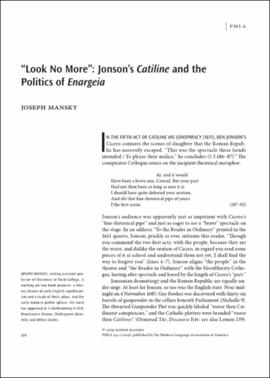| dc.contributor.author | Mansky, Joseph | |
| dc.date.accessioned | 2020-10-23T20:16:26Z | |
| dc.date.available | 2020-10-23T20:16:26Z | |
| dc.date.issued | 2019-03 | |
| dc.identifier.citation | Mansky, Joseph.“‘Look no more’: Jonson’s Catiline and the Politics of Enargeia,” PMLA 134.2 (2019): pp .332–350. | en_US |
| dc.identifier.uri | https://hdl.handle.net/11244/325627 | |
| dc.description.abstract | In his play Catiline His Conspiracy, Ben Jonson allegorizes Cicero’s fight to save the Roman Republic as a battle against the kind of spectacular drama that, Jonson claimed, his audiences so enjoyed. This metatheatrical polemic hinges on the rhetorical technique of enargeia: the power of language to conjure an image. For the early moderns, enargeia resolved the “paradox of representation”—the contradiction between “making present” and “standing for”—by subordinating visual presence to verbal illusionism. Jonson, aligning neoclassical poetics with humanist historiography, dramatizes this hierarchy of representation. In Catiline, Cicero’s rhetoric puts visions of violence before his audience’s eyes only to prevent their realization onstage. The play thus seeks to exorcise the specter of political violence that haunted early modern England and the Roman Republic alike. Yet the rhetoric of Jonson’s Cicero proves just as coercive as the spectacular violence that it has replaced. From Jonson’s time to ours, separating rhetoric from violence has remained the challenge of republicanism. (JM) | en_US |
| dc.language | en_US | en_US |
| dc.subject | Ben Jonson | en_US |
| dc.subject | Cicero | en_US |
| dc.subject | Elizabethan drama | en_US |
| dc.subject | Enargeia | en_US |
| dc.subject | Catiline His Conspiracy | en_US |
| dc.title | “Look No More”: Jonson’s Catiline and the Politics of Enargeia | en_US |
| dc.type | Article | en_US |
| dc.description.peerreview | Yes | en_US |
| dc.identifier.doi | 10.1632/pmla.2019.134.2.332 | en_US |
| ou.group | College of Arts and Sciences::Department of English | en_US |

